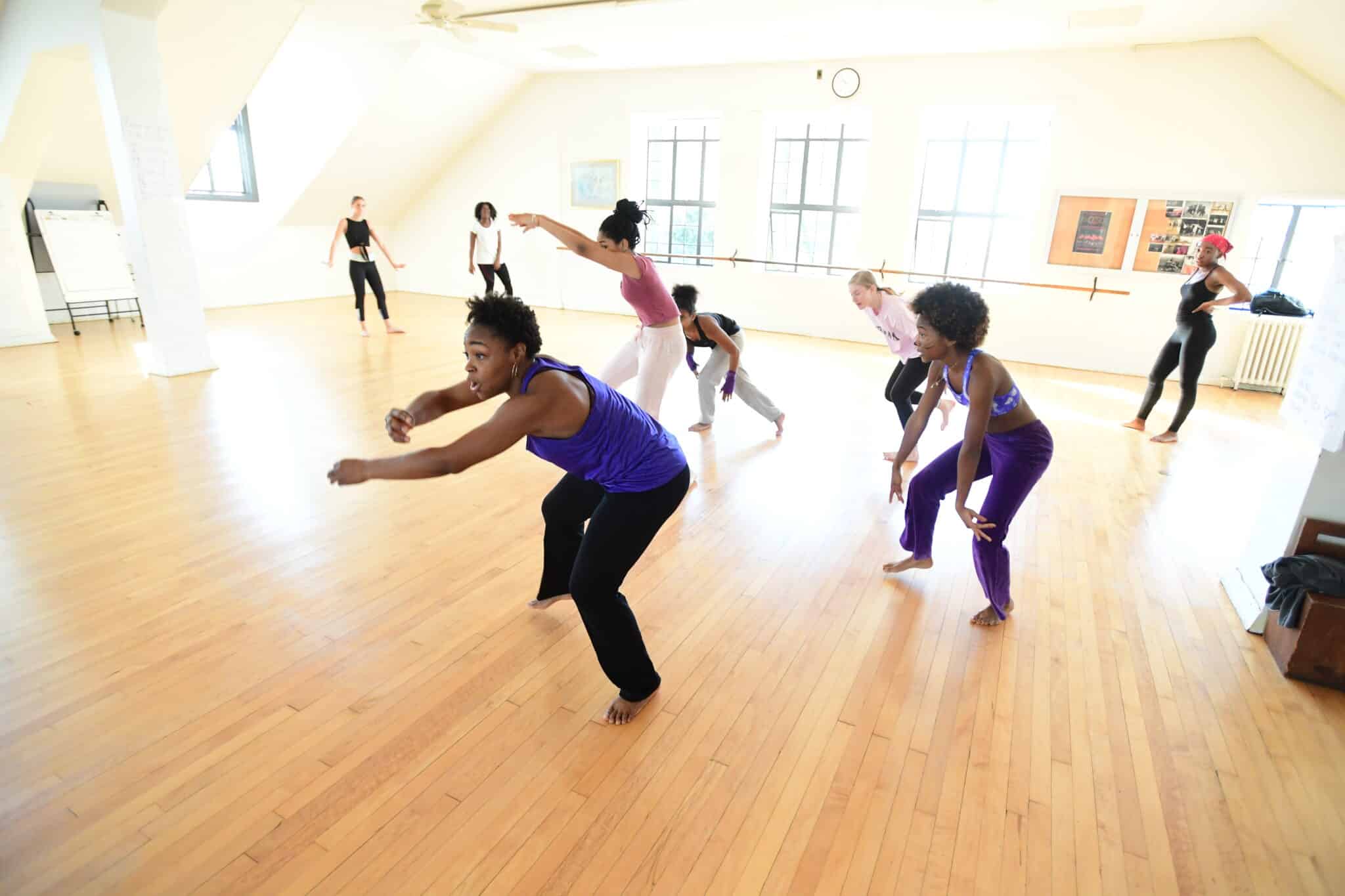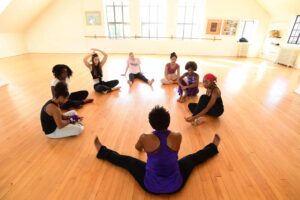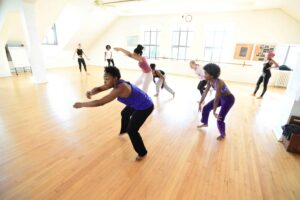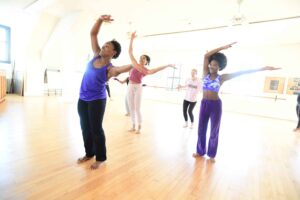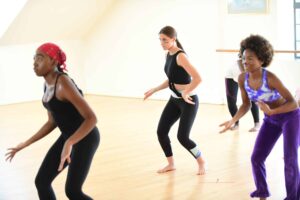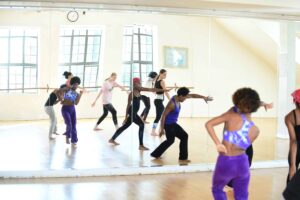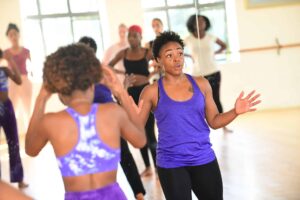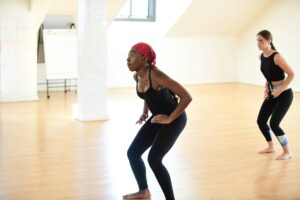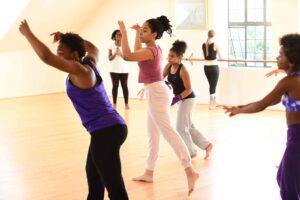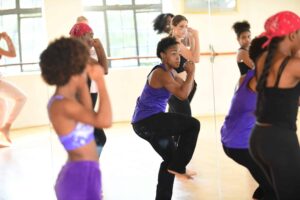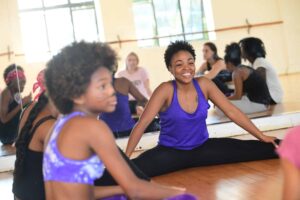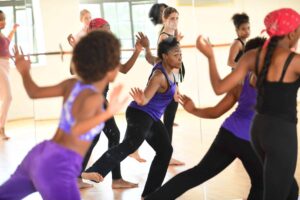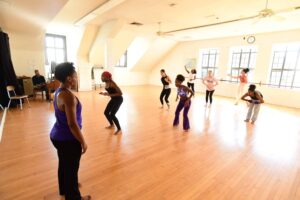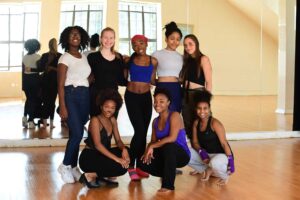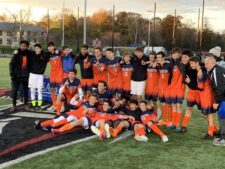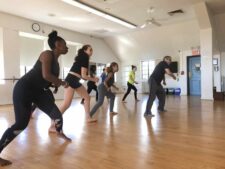“What is your intention today?”
The question is posed to seven Fieldston Upper girls who are sitting down in a circle in Fieldston’s dance studio. As implied by the face paint some students wear and by the bright fall sun streaming through the third-floor windows, it is the morning of Halloween, though the students have been answering some version of this question every Wednesday for the past couple of weeks. Their responses today run the gamut from the expected (“learn the choreography,” “practice”) to the abstract (“connectivity,” “positivity”).
The question is asked by dancer and guest teacher Matia Johnson — who is here as envoy for renowned modern choreographer Camille A. Brown — as the students stretch and prepare for the day’s 80-minute rehearsal. Johnson is helping them stage one of Brown’s recent works called New Second Line.

The group is part of the Fieldston Dance Company, a two-year program open to selected students after audition, which involves training in dance technique, improvisation, composition, and choreography. As part of the dance faculty’s efforts to expose students to renowned modern choreographers like Paul Taylor, Alvin Ailey, José Limón, and Trisha Brown, Fieldston Dance Company director Rob O’Neill brings in a professional choreographer every fall to work with the students. The goal, according to O’Neill, is “to expose our dancers to the choreographer, an excerpt from a dance, and the process that this choreographer uses.” O’Neill also tries to offer his students varied experiences — last year, for example, students worked with Doug Varone, an Obie Award winner whose fluid work is now making for a helpful contrast to the faster approach seen in Brown’s piece.
Learning everything from how a dance is conceived to seeing how a rehearsal is run becomes a chance for dance majors to experience what it’s like to be a member of a professional company — and it serves as the groundwork for their own choreography they’ll produce later in the spring.
Your intention will guide how you move.
The goal is never to mimic or to replicate what they’ve done but to learn from the process these visiting choreographers model for them. This time around, as O’Neill put it, students “will be taking something they’ve digested from Camille A. Brown’s piece, and then that will influence the pieces they create themselves,” which they’ll present at the repertory dance performance in late January.
Today, though, the focus is entirely on the excerpt that was chosen for this fall: a 10-minute section of New Second Line. In keeping with Brown’s longstanding commitment to exploring black identity in her choreography, this 2006 piece demands to be studied in context. The “new,” after all, signals that there’s a history here waiting to be unearthed. And that’s exactly what Johnson did on her very first meeting at ECFS: rather than dancing that first day, students were treated to a history lesson that would help them better understand her intent.
New Second Line was created in 2006 in response to Hurricane Katrina and its devastating effect on mostly African-American communities. As Johnson explained, the piece “is in celebration of the people of New Orleans, their perseverance and pain as a result of the hurricane. It honors and celebrates the lives of those who are still there, keeping the culture of New Orleans going and thriving. But it also honors the lives that were lost.” Such a mix of celebratory and mournful sensibility is at the heart of the longstanding tradition of the “second line.”
Harkening back all the way to West African circle dances, the second line refers to the group of men, women, and children who follow brass band parades (ergo: “second”). Invoking this tradition in both title and movements alike, Brown hopes to shine light on the resilience of the Louisiana city.
The second line presents a unity that’s not premised on unison.
This poses, as Johnson knew it would, a challenge for these ECFS students. Second lines demand a different way of moving, as well as a different way of relating to your fellow dancers. To watch the second line parades (which take place almost year-round in New Orleans) is to see a community coming together and celebrating at each individual’s pace. “Nobody looks the same — ever!” Johnson says. “You have a grandma who’s 85 and then you have a six year old. It looks beautiful together but there’s a different energy. You bring your experiences, you bring yourself. That’s important to learn.”

The second line presents a unity that’s not premised on unison. To ease her eager young dancers into that kind of movement, Johnson makes it a central part of their warm-up. While at first their stretching looks no different than the kind you’d practice at a typical dance class, it soon becomes clear that these are movements rooted in second line. The footwork demands they travel around the dance studio with a weightiness that, as Johnson reminds them, will help ground their movements in their body.
“See each other,” Johnson encourages them as they work their way around the room, nudging the girls to make eye contact with each other and be more aware of the physical spaces they share. “Don’t be awkward about it!” The more they move and throw their bodies into this shuffling footwork, the looser they become, the more eager they are to interact with one another.
The looseness is vital: Brown’s moves ask dancers to work with their entire body in ways that feel both elastic and assertive. Outstretched arms steer a turn. Large leaps guide a move. Even slowed down and set to accompanying piano chords, the dance is dynamic and soulful — and, to judge by the sweat and the playful complaints that pepper the rehearsal (“I’m on fire!”), taxing in all the right ways.
After working in small groups and tackling various interlocking pieces of New Second Line, Johnson assembles the students to try and get through everything as a group. Here again is a chance to see this budding dance ensemble follow the footsteps of dance companies everywhere: they first do a runthrough at practice tempo, then dance at the speed of the actual music. (In this case, “New Second Line” by Los Hombres Calientes, featuring Kermit Ruffins.) This comes with its own expected frustrations — missed steps, failed cues — and mostly shows how much more work the students have ahead of them. Work they all seem eager to tackle.
At the end of class, all of the dancers assemble again in a circle. Johnson encourages them to look back at what they’ve accomplished, what has been challenging, and, more importantly, what they might bring for next week. The emphasis, for Johnson, is to stress in these bookend moments that being in an ensemble and working on a piece together is all about a process. It’s as much about working as individuals as it is about learning to play off one another as a group.
That’s when Johnson’s words about clarity and intention, which may have seemed abstract for a dance class, suddenly click. You cannot move without an aim, without a goal. It is not only about how you guide your limbs through choreography but also about how you handle yourself in any given situation. Seeing these students working through such intricate choreography, one realizes that Johnson’s simple dictum is a radical call, even to those who never set foot in a dance studio: “Your intention will guide how you move.”
